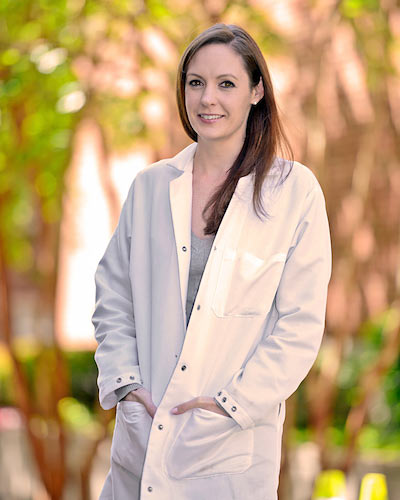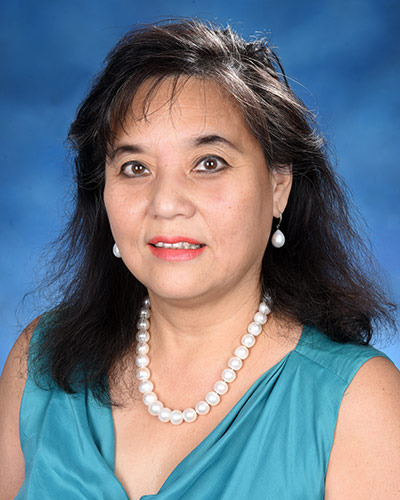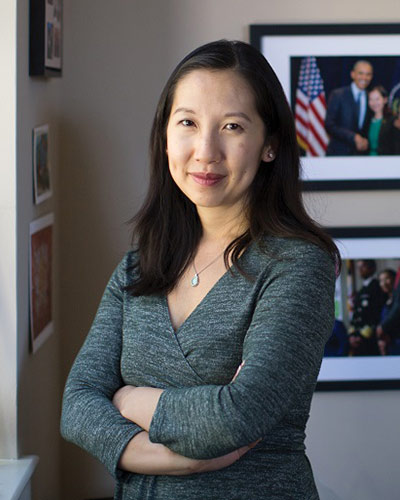September 11, 2017 | Joanne Morrison

Breakthrough Research Recognized with 2017 Grand Prize from Science Magazine
Understanding what changes take place in the brain after consuming addictive agents like cocaine may help set a blueprint for directly tackling addiction, according to research conducted by Meaghan Creed, Assistant Professor of Pharmacology at the University of Maryland School of Medicine (UM SOM). Dr. Creed, a neuroscientist who studies deep brain stimulation, has developed an approach that reversed cocaine addiction in mice, and she is now researching how this might work with opioids.
Dr. Creed was recognized for her work in this area and named the 2017 grand prize winner of a joint award issued by Science and Beijing, China-based PINS Medical Equipment Co.
Her essay, “Toward a Targeted Treatment for Addition,” which was published recently in Science, outlines her research using deep brain stimulation combined with pharmacology on mice to reverse brain changes brought on by cocaine addiction.
Dr. Creed noted that a major challenge that has kept scientists from developing treatments for addiction is that diagnoses are based on behavior rather than on observable changes in the brain. Her research focused on observing neural circuits, or clusters of neurons that work together and connected by synapses, which are the structures that enable nerve cells to communicate with each other. Her research showed that synapses in the brain are modified by exposure to addictive compounds, promoting drug-seeking behaviors that are persistent even after addictive agents leave the body.
“This is why even after long periods of abstinence, patients with addiction still experience cravings and often relapse,” said Dr. Creed.
Over the past three years, Dr. Creed’s neuromodulation research, conducted largely as her postdoctoral research in the Department of Clinical Neuroscience at the University of Geneva, in Geneva, Switzerland, studied how cocaine exposure modified synapses in the reward systems of mice. Researchers treated the animals with cocaine for five days and then measured their movements to identify addictive behavior.
Dr. Creed and her colleagues developed an approach that combined electrical deep-brain stimulation with a dopamine D1 receptor inhibitor drug, causing the mice to behave as if they had never received cocaine. This method effectively offered a potential blueprint for correcting neural circuit dysfunction after prolonged use of addictive agents like cocaine. This method could ultimately improve existing treatments for addictive disorders by controlling craving symptoms in the brain, according to Dr. Creed.
Dr. Creed noted in her essay that this approach may not be limited to addiction. "Ultimately, my goal is to develop specific neuromodulatory interventions that can normalize circuit function and treat behavioral symptoms of other conditions characterized by dysfunction of the reward system, such as ADHD, bipolar disorder or depression," she said.
“Dr. Creed promises to be one of the most impactful scientists of her generation. In the short time that she has been on faculty at University of Maryland School of Medicine she has already moved the needle forward in research into drug addiction and its causes through her own work and collaboration with others. We are delighted she joined the UM SOM team and look forward to watching her star continue to rise," said Margaret M. McCarthy, PhD, Professor and Chair of the Department of Pharmacology.
Dr. Creed was recognized at the 8th Neuromodulation Conference in Jinan, Shandong Province of China on Sept. 2. The conference was organized by the Chinese Neuromodulation Society.
“Dr. Creed’s research that she continues here at the University of Maryland School of Medicine is critical toward understanding and tackling the very serious problems we face with addiction,” said UM SOM Dean E. Albert Reece, MD, PhD, MBA, who is also Vice President for Medical Affairs at the University of Maryland and the John Z. and Akiko K. Bowers Distinguished Professor.
About the University of Maryland School of Medicine
Commemorating its 210th Anniversary, the University of Maryland School of Medicine was chartered in 1807 as the first public medical school in the United States. It continues today as one of the fastest growing, top-tier biomedical research enterprises in the world -- with 43 academic departments, centers, institutes, and programs; and a faculty of more than 3,000 physicians, scientists, and allied health professionals, including members of the National Academies of Science, Engineering and Medicine, and a distinguished recipient of the Albert E. Lasker Award in Medical Research. With an operating budget of more than $1 billion, the School of Medicine works closely in partnership with the University of Maryland Medical Center and Medical System to provide research-intensive, academic and clinically-based care for more than 1.2 million patients each year. The School has over 2,500 students, residents, and fellows, and nearly $450 million in extramural funding, with more than half of its academic departments ranked in the top 20 among all public medical schools in the nation in research funding. As one of the seven professional schools that make up the University of Maryland, Baltimore campus, the School of Medicine has a total workforce of nearly 7,000 individuals. The combined School and Medical System (“University of Maryland Medicine”) has a total budget of $5 billion and an economic impact of nearly $15 billion on the state and local community. The School of Medicine faculty, which ranks as the 8th-highest public medical school in research productivity, is an innovator in translational medicine with 600 active patents and 24 start-up companies. The School works locally, nationally, and globally, with research and treatment facilities in 36 countries around the world. Visit medschool.umaryland.edu/
Contact
Department of Anesthesiology
(410) 328-6120 (phone)
(410) 328-5531 (fax)
newsletter@som.umaryland.edu
University of Maryland School of Medicine
Joanne Morrison
Director of Marketing and Public Relations
University of Maryland School of Medicine
jmorrison@som.umaryland.edu
Office:(410) 706-2884
Mobile:(202) 841-3369
Related stories

Tuesday, July 06, 2021
UM School of Medicine Researchers Receive NIH Avant-Garde Award for Out-Of-Box Concept to Cure HIV and Treat Co-Existing Addiction
Linda Chang, MD, MS, Professor of Diagnostic Radiology & Nuclear Medicine at the University of Maryland School of Medicine (UMSOM), received the National Institute on Drug Abuse (NIDA) 2021 Avant-Garde Award (DP1) for HIV/AIDS and Substance Use Disorder Research — a National Institutes of Health (NIH) Director’s Pioneer Award. This prestigious award supports researchers with exceptional creativity, who propose high-impact research with the potential to be transformative to the field.

Friday, April 29, 2016
Baltimore City Health Commissioner Speaks at University of Maryland School of Medicine Addiction Conference
Baltimore City Health Commissioner Leana Wen and other experts recently addressed ways to decrease the epidemic of opioid overdose deaths at a conference on mental health and addiction.
